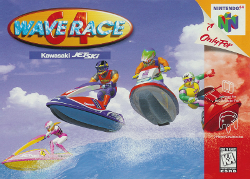
Wave Race 64 is a 1996 racing video game developed and published by Nintendo for the Nintendo 64. Gameplay involves the player racing on a personal watercraft on a variety of courses while successfully manoeuvring the vehicle around various buoys. A multiplayer mode where two players can compete against each other on a chosen course is also included. The game supports the Controller Pak, which allows players to transfer saved data from one game cartridge to another.
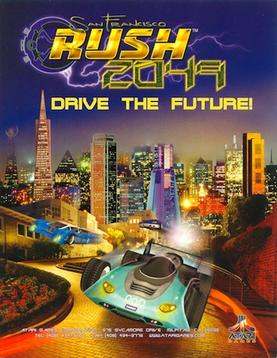
San Francisco Rush 2049 is a racing video game developed and manufactured by Atari Games for arcades. It was ported to the Nintendo 64, Game Boy Color, and Dreamcast by Midway Games West. The arcade machine was released in 1999; home versions followed in 2000 on September 7 for North America and November 17 for Europe. It is the third game in the Rush series and the sequel to San Francisco Rush: Extreme Racing and Rush 2: Extreme Racing USA. It is the last game in the Rush series to be set in the city of San Francisco and the last released on a Nintendo console. It also serves as the final game for the Atari Games label, which was retired shortly after the arcade release. The Dreamcast version was later re-released as part of Midway Arcade Treasures 3 for the PlayStation 2, Xbox, and GameCube and later for Windows as part of Midway Arcade Treasures Deluxe Edition.

Top Gear Rally is a 1997 racing video game developed by Boss Game Studios and released for the Nintendo 64. A follow-up to Kemco's original Top Gear game, it features a championship mode where a single player must complete six seasons of two to four races, as well as a multiplayer mode where two players may compete against each other via a split-screen display. The game's tracks combine both road and off-road surfaces and can be played in different weather conditions, including night, fog, rain, and snow. Players may customize their car with different tire grips and adjust its suspension stiffness and steering sensitivity. An option that allows players to custom paint their cars is also included.

Automobili Lamborghini is a 1997 racing video game developed and published by Titus France for the Nintendo 64. It is a successor to Lamborghini American Challenge.

Need for Speed II is a 1997 racing video game released for PlayStation and Microsoft Windows. It is a part of the Need for Speed series and is the second installment, following The Need for Speed.

Batman Forever: The Arcade Game is a beat 'em up video game based on the movie Batman Forever. The subtitle is used to differentiate it from Batman Forever, another beat 'em up published by Acclaim at around the same time. One or two players, playing as Batman and Robin, fight Two-Face, the Riddler, and numerous henchmen.
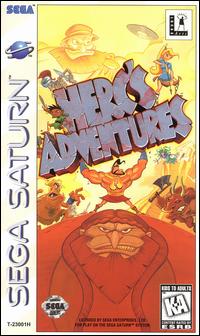
Herc's Adventures is a video game released for the Sega Saturn and PlayStation by LucasArts in 1997. The overhead, action-adventure format is similar to Zombies Ate My Neighbors. Up to two players each take on the role of one of three ancient Greek heroes: Herc (Hercules), Atlanta (Atalanta), or Jason, who are on a quest to defeat Hades and save the goddess of nature, Persephone. In 2014, it was released for PSN in North America.

ATV: Quad Power Racing 2 is a racing video game developed by Climax Brighton and published by Acclaim Entertainment under their AKA Acclaim label for PlayStation 2, GameCube and Xbox. It's a sequel to ATV: Quad Power Racing. The game is notable for its inclusion of a three-wheeled ATV, not seen in any other video games, and not sold in the real world since the late 1980s.

GT Advance Championship Racing, known in Japan as Advance GTA, is a racing game developed by MTO and published by THQ. It was a launch title for the Game Boy Advance. The game's sequel, GT Advance 2: Rally Racing, was released on June 30, 2002 in North America.

NASCAR '98 is a racing simulator video game developed by Stormfront Studios, published by EA Sports, and released in 1997 for Sony PlayStation and Sega Saturn. This was the first game in the EA Sports NASCAR series.

AeroGauge is a hovercraft racing game designed for the Nintendo 64 game console and released in 1998. The game was developed by Locomotive and published by ASCII it is conceptually similar to Psygnosis' Wipeout or Acclaim's Extreme G. The main difference is that the vehicles in the game fly instead of hovering. AeroGauge garnered mediocre reviews, with criticism directed at its routine concept, excessive pop up, lack of weapons and power-ups, and overly high difficulty.

F1 Pole Position 64, released in Japan as Human Grand Prix: The New Generation, is a racing video game for the Nintendo 64 developed by Human Entertainment and published by Human Entertainment in Japan, and published by Ubi Soft for North American and Europe. It is the fifth and final game in the Human Grand Prix / F1 Pole Position series, featuring Formula One branding.

Test Drive 4 is a racing game developed by Pitbull Syndicate and published by Accolade for PlayStation and Microsoft Windows in 1997. It offers 14 supercars and muscle cars, and tasks the player with beating computer opponents in tracks set in real life locales. The game's tracks are long courses with rural roads and urban streets, and commonly feature traffic and short corners. The player has to arrive at each checkpoint before the Checkpoint Timer expires, resulting in additional time, and crossing the finish line is required to complete the race. Test Drive 4's commercial success briefly made Test Drive the best selling racing franchise, but the game received mixed reviews. In 1999 the game was republished under the Greatest Hits label after selling 850,000 copies within one year of its release.

Machine Hunter is a top-down shooter game developed by Eurocom Entertainment Software, published by MGM Interactive and distributed in Europe by Eidos Interactive. It was developed and released simultaneously in 1997 for Windows 95 and PlayStation console. It has been described as a clone of the 1995 game Loaded, in that it uses an overhead perspective, extensive lighting effects, and over-the-top bloodshed.
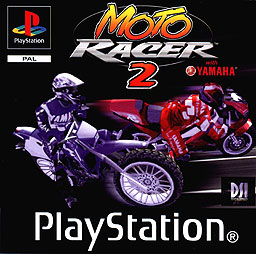
Moto Racer 2 is a motocross racing game developed by Delphine and published by Electronic Arts for PlayStation and Microsoft Windows. It is part of the Moto Racer series, and is the sequel to Moto Racer.

Thunder Truck Rally is a monster truck racing video game developed by Reflections and published by Psygnosis where players select a monster truck or otherwise 4X4 vehicle equipped with monster truck tires and have the option of either racing or crushing cars in an arena.

MLB ‘98 is a Major League Baseball video game for the PlayStation developed by Sony Interactive Studios America and released in August 1997. It precedes MLB '99 and is the sequel to MLB Pennant Race.
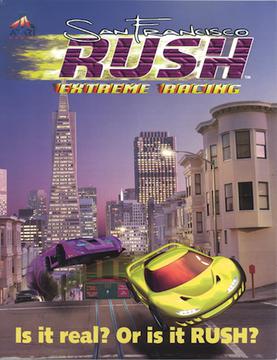
San Francisco Rush: Extreme Racing is a video game developed and published by Atari Games. This game was first released in arcades in 1996 and was ported to Nintendo 64 in 1997 and the PlayStation in 1998. San Francisco Rush: Extreme Racing is the first game in the Rush series.

Porsche Challenge is a racing video game developed by SCE Studios Soho and published by Sony Computer Entertainment released for the PlayStation. The player and computer-controlled cars in the game consist of Porsche Boxsters.
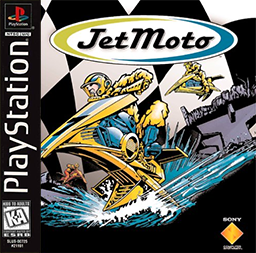
Jet Moto is a 1996 racing video game developed by SingleTrac and published by Sony Computer Entertainment for the PlayStation video game console and PC. The PlayStation version was released in North America on October 31, 1996; in 1997 for Europe in February and Japan on August 7. The PC version was released on November 13, 1997. Jet Moto was made available for the PlayStation Portable and PlayStation 3 via the PlayStation Network in February 2007. Developers chose fictional hovering bikes instead of wheeled motorcycles initially to resolve performance concerns. Other performance concerns led the team to develop two different physics systems—one for the player, and one for the 19 computer racers.



















